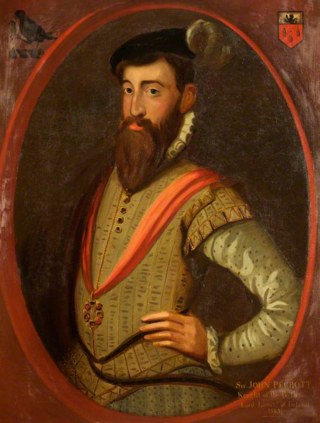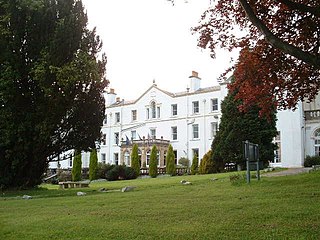
Viscount St Davids, of Lydstep Haven in the County of Pembroke, is a title in the Peerage of the United Kingdom. It was created in 1918 for John Philipps, 1st Baron St Davids. The Philipps family descends from Sir John Philipps, who represented Pembrokeshire in the House of Commons. In 1621 he was created a Baronet, of Picton Castle in the County of Pembroke, in the Baronetage of England. His grandson, the third Baronet, also sat as Member of Parliament for Pembrokeshire. He was succeeded by his son, the fourth Baronet. He represented Pembroke and Haverfordwest in Parliament. His son, the fifth Baronet, sat for Haverfordwest. He was succeeded by his younger brother, the sixth Baronet. He represented Carmarthen, Petersfield and Pembrokeshire in the House of Commons.

Sir John Perrot served as lord deputy to Queen Elizabeth I of England during the Tudor conquest of Ireland. It was formerly speculated that he was an illegitimate son of Henry VIII, though the idea is rejected by modern historians.
Sir John Perrot, was a figure of unusual power and influence in Tudor Britain and Ireland. Born near Haverfordwest in 1528, he inherited wealth and power – the Perrots had been accumulating both in west Wales for centuries – and gained more ingratiating himself with the English court.
His own son described him as a "very cholericke" man, who "could not brooke any crosses". He had already gathered many offices by the time he was sent to Ireland in 1571 as President of Munster to suppress a rebellion. His methods were characteristically violent – he hanged over 800 of the rebels – but he resigned after two years, having failed in his mission.
Back in west Wales he contented himself with self-enrichment and self-glorification, rebuilding in grand style his two main homes, Carew Castle and Laugharne Castle. He returned to Ireland as 1584 as Lord Deputy, with the task of crushing the Irish and colonising their land. Again unsuccessful, he returned, was falsely accused of treason by his many enemies, and died in the Tower of London in 1592, possibly of poisoning.
Robert fitz Martin was a knight from Devon whose father, Martin de Turribus, was the first Norman Lord of Kemes, in what had previously been the Dyfed part of Deheubarth. Fitz Martin inherited the Lordship of Kemes from his father, and founded St Dogmaels Abbey c. 1118. He was the first of the FitzMartin line. His descendants continued to hold lands in England and Wales until the 14th century.

William Edwardes, 1st Baron Kensington of Johnston Hall, Pembrokeshire, was a British landowner and a long-standing Member of Parliament.

Sir John Philipps, 6th Baronet PC was a Welsh Jacobite politician.
This is a list of High Sheriffs of Pembrokeshire. The High Sheriff is the oldest secular office under the Crown. Formerly the High Sheriff was the principal law enforcement officer in the county but over the centuries most of the responsibilities associated with the post have been transferred elsewhere or are now defunct, so that its functions are now largely ceremonial. The High Sheriff is reappointed in March of each year.

Sir William Davies was a Welsh Liberal politician.

Roch Castle is a 12th-century castle, located at Roch near Haverfordwest, Wales.
Slebech was a community in Pembrokeshire, Wales, which is now part of the combined community of Uzmaston and Boulston and Slebech, a sparsely populated community on the northern shore of the Eastern River Cleddau. The community shares boundaries with the communities of Wiston and Llawhaden and mainly consists of farmland and woodland. Much of the community is within the Pembrokeshire Coast National Park and Picton Castle's stable block loft is an important breeding roost for the rare Greater Horseshoe Bat.
Lieutenant General Hugh Royds Stokes Massy was a British Army officer who served during the First and Second World Wars.

Court Colman Manor is a historic Tudor mansion in Pen-y-fai, Bridgend, South Wales. The property belonged to Margam Abbey until the Dissolution, after which it passed through several hands. It was built in 1766 by Hopkin Rees (1729–1780) and enlarged and modified in 1907 by Robert William Llewellyn (1848–1910).

Sir John Owen, 1st Baronet, born John Lord, was a British Tory politician from Wales. He sat as a Member of Parliament (MP) for over fifty years. His wealth came from coal mining but he lost most of his fortune as a result of costly electoral campaigns in Pembrokeshire, most notably those of 1831.

Richard Philipps, 1st Baron Milford, known as Sir Richard Philipps, Bt, from 1764 to 1776, was a Welsh landowner and Tory politician who sat in the House of Commons between 1765 and 1812.

Sir John Henry Scourfield, 1st Baronet was a Welsh Conservative politician who sat in the House of Commons from 1852 to 1876.

The Big House, also known as Landshipping House, is a historic house on the banks of the River Cleddau in Landshipping, Pembrokeshire, Wales.

The Stepney family are an English family, who having originated in Stepney, London, made their fortune in lands surrounding Llanelli, West Wales.

Pill Priory is a Tironian house founded near Milford Haven, Pembrokeshire, South West Wales in the late 12th century.

Hardwick Hall in Sedgefield, County Durham is a building of historical significance and is listed on the English Heritage Register. A major part of it was built in the late 1700s but it is possible that some of it dates from about 1634. It was the residence for many notable people for two centuries. It is now a hotel which provides accommodation and restaurant services and caters for special events particularly weddings.
Hartsfield Manor is an early Victorian house of historical significance located in Betchworth, Surrey, England. It was built in the 1860s as a private residence and served this purpose for several notable people until World War II. After this it became a hotel and then a training centre. It is now a venue for special events such as conferences and weddings.
John Barlow was a Welsh politician who sat in the House of Commons from 1715 to 1718.

















